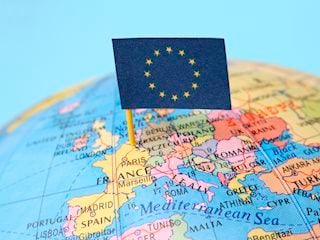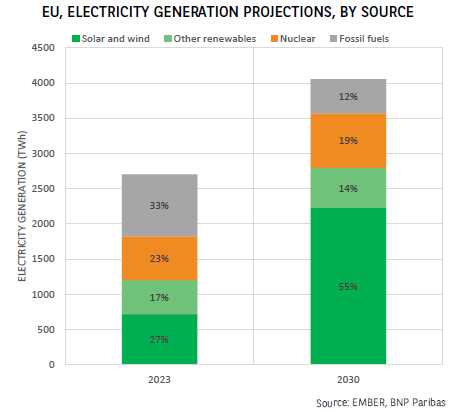The “green” electricity revolution is well on its way
|
In 2019, the European Union (EU) adopted a very ambitious Green Deal, setting a 2050 climate neutrality target for the 27 member states. Since then, the Fit for 55 legislative package (in 2021) has been introduced, followed by the series of REPowerEU directives (in 2023) detailing the process to speed up reducing greenhouse-gas emissions (to at least twice the current pace). The main focus has been on developing renewable energies, whose share is set to double within six years, accounting for 42.5% of end-energy use by 2030.
We are seeing a revolution with electricity at its heart. In order to drive the transformation of usages (such as the gradual phasing out of internal combustion engine vehicles and the replacement of oil and gas boilers with heat pumps), the sector will have to significantly increase its production (by around 50%) by 2030, based on demand projections from the EMBER institute1. At the same time, the very nature of this production will have to change, so that EU’s electricity generation will mainly rely on solar and wind power (at 55% in 2030, compared to the current level of 27%, see chart).
Recent trends are encouraging. Since the outbreak of the war in Ukraine, “green” investments have accelerated, with solar and wind power largely (and probably permanently) replacing gas in EU electricity generation2. This breakthrough has been achieved with a stable or even slightly reduced production volume (around 2,800 terawatt hours per year for a decade) and will now need to be entrenched with the increasing electricity demand, which will involve considerable investments. Under the (low or high) scenarios used, wind and photovoltaic production capacities should be increased by a factor of 2.5 to 3 by 2030 if the EU wants to achieve its roadmap.
Information on these pages contains forward-looking statements that involve risks and uncertainties. Markets and instruments profiled on this page are for informational purposes only and should not in any way come across as a recommendation to buy or sell in these assets. You should do your own thorough research before making any investment decisions. FXStreet does not in any way guarantee that this information is free from mistakes, errors, or material misstatements. It also does not guarantee that this information is of a timely nature. Investing in Open Markets involves a great deal of risk, including the loss of all or a portion of your investment, as well as emotional distress. All risks, losses and costs associated with investing, including total loss of principal, are your responsibility. The views and opinions expressed in this article are those of the authors and do not necessarily reflect the official policy or position of FXStreet nor its advertisers.
